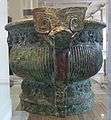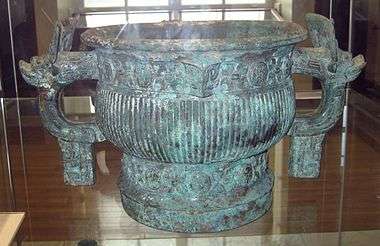Kang Hou Gui
|
The Kang Hou Gui vessel on display at the British Museum | |
| Material | Bronze |
|---|---|
| Size | 21.6 cm High, 42 cm Diameter |
| Created | 11th Century BC |
| Present location | British Museum, London |
| Registration | Asia OA 1977,0404.1 |
The Kang Hou Gui is a bronze vessel that is said to have been found near the city of Huixian, Henan province, central China. Dating to the Western Zhou period, this ancient Chinese artefact is famous for its long inscription. It has been part of the British Museum's Asian Collections since 1977.[1]
Provenance
Little is known about the original context in which the bowl was found. However, based on its inscription, it is conjectured by archaeologists to have been deposited in Wei, near present-day Huixian in Henan province. Owners of the vessel once included the British diplomat Dugald Malcolm, before being purchased by the British Museum with the support of the Brooke Sewell bequest.[1]
Description
This cast bronze gui is a lavishly decorated food bowl that was used during rituals for worshipping ancestors. This high based vessel has large handles shaped like tusked animal heads that have eaten birds as their beaks are shown peaking out of their predator's mouths.[2] Between the rim and the incised vertical lines is a narrow band decorated with an animal head and alternating roundels and quatrefoils. A similar band (without the animal heads) is engraved on the foot of the container. The Kang Hou Gui vessel was chosen by Neil MacGregor, the Director of the British Museum, as object 23 in the BBC Radio programme A History of the World in 100 Objects.[2]
Inscription
The ancient Chinese inscription on the inside of the bowl tells how King Wu's brother, Kang Hou, who was the Duke of Kang, and Mei Situ were given territory in Wei. The inscription also describes a rebellion by remnants of the Shang dynasty, and its defeat by the Zhou, which helps to date the vessel. Because historians know when this unsuccessful rebellion against the Zhou dynasty took place, they are able to accurately date the manufacture of this important object to the 11th Century BC.[3]
See also
- Huixian Bronze Hu, also in the British Museum
Gallery
-

Side view of the Gui vessel in the British Museum
-

The vessel viewed from above with inscription in the centre
-

Detail of the Chinese inscription
References
- 1 2 British Museum Collection gui, British Museum, retrieved 22 December, 2014
- 1 2 Episode 23 - Chinese Zhou Ritual Vessel, Episode transcipt, BBC, retrieved 22 December 2014
- ↑ Chinese Zhou ritual vessel (gui), British Museum Highlights, retrieved 22 December 2014
Further reading
- J Rawson, The British Museum Book of Chinese Art (London, British Museum Press, 2007)
- J. Rawson, Chinese bronzes: art and ritual (London, The British Museum Press, 1987)
| Preceded by 22: Sphinx of Taharqa |
A History of the World in 100 Objects Object 23 |
Succeeded by 24: Paracas Textile |
